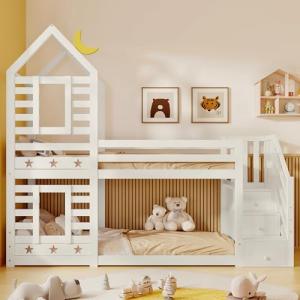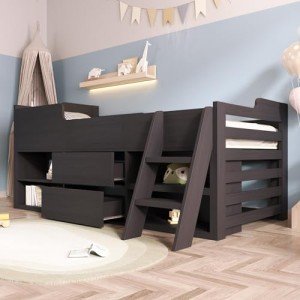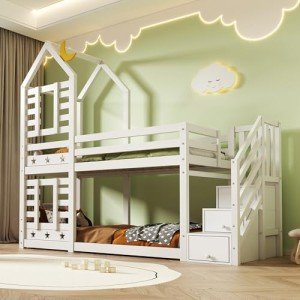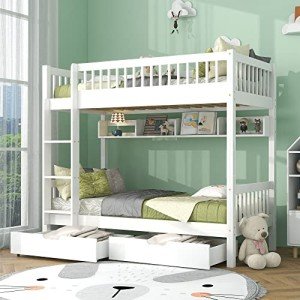In recent years, wooden bunk beds have surged in popularity, particularly among families with children and those living in smaller spaces. These practical furnishings not only save space but also add a touch of warmth and aesthetic appeal to a room. When combined with smart storage options and an array of mattress choices, wooden bunk beds can transform a simple bedroom into a versatile living space. This guide explores the benefits, configurations, and considerations of wooden bunk beds equipped with storage solutions and mattress options.
The Advantages of Wooden Bunk Beds
Space-Saving Design
One of the primary reasons people opt for bunk beds is their ability to maximize floor space. By stacking beds, these structures free up area for other furniture, activities, or storage. This makes wooden bunk beds particularly attractive for:
- Children’s Rooms: They provide a shared sleeping space without taking up as much room.
- Guest Rooms: For infrequent visitors, bunk beds are a great way to accommodate multiple sleepers.
Aesthetic Appeal
Wooden bunk beds offer a natural look that can complement various design aesthetics:
- Traditional: Rich, dark woods can lend a classic feel.
- Modern: Light woods or painted finishes align with contemporary styles.
- Rustic: Reclaimed wood designs add character and warmth.
Durability
Wood is a naturally strong material that withstands wear and tear:
- Longevity: A well-constructed wooden bunk bed can last for years, providing value for the investment.
- Sturdiness: Solid wood bed frames tend to be sturdier than metal ones, offering peace of mind for restless sleepers.
Environmentally Friendly
Sustainable woods can be used to create eco-friendly bunk beds. Buyers can opt for beds made from FSC-certified woods, ensuring responsible sourcing.
Features of Wooden Bunk Beds with Storage
Built-In Storage Solutions
To make the most of limited space, many wooden bunk beds come with built-in storage options. These can include:
- Under-Bed Drawers: Perfect for storing clothing, toys, or linens.
- Shelf Units: Positioned either above or beside the bunk beds, these can hold books, nightlights, or other essentials.
- Stairs with Storage: Instead of a ladder, some models feature stairs that include pull-out drawers.
Configurations
Wooden bunk beds come in various configurations to suit different needs, including:
| Configuration Type | Description |
|---|---|
| Twin over Twin | Two twin-size beds stacked, ideal for children. |
| Full over Full | Two full-size beds perfect for older kids or young adults. |
| Twin over Full | One twin bed stacked over a full bed, providing flexibility for different aged sleepers. |
| L-Shaped Bunk Beds | Two beds set in an L-shape, offering more floor space and comfort. |
Customization Options
Many manufacturers offer customizable options for wooden bunk beds, allowing buyers to select:
- Wood Type: Choices can range from pine to walnut, affecting both cost and appearance.
- Finish: Customers can select between natural, stained, or painted finishes.
- Accessories: Items such as guardrails and ladders can be tailored to meet safety needs.
Mattress Choices
The choice of mattress is critical for ensuring a good night’s sleep. Here are some options to consider:
Foam Mattresses
Pros:
- Lightweight and easy to handle.
- Conform to the sleeper's body for added comfort.
Cons:
- May retain heat, leading to discomfort for some.
Innerspring Mattresses
Pros:
- Offer robust support and bounce.
- Durable and widely available.
Cons:
- Heavier than foam mattresses.
Hybrid Mattresses
Pros:
- Combine foam and springs for a balance of comfort and support.
- Suitable for a wide range of sleeper preferences.
Cons:
- Generally more expensive than other options.
Loft Mattresses
Specifically designed for bunk beds, loft mattresses typically have a lower profile to ensure safety and fit properly in the confined space.
FAQs
How much weight can a wooden bunk bed hold?
The weight capacity of wooden bunk beds varies based on the materials and design. On average, they can support between 200 to 400 pounds per bunk.
Are wooden bunk beds safe for children?
Yes, wooden bunk beds are generally safe for children, especially those constructed with safety in mind, including side rails, sturdy ladders, and a secure upper bunk.
How do I choose the right mattress for a bunk bed?
When selecting a mattress for a bunk bed, consider the recommended thickness (usually between 6 to 8 inches for upper bunks) and ensure it fits snugly within the bed frame to prevent slipping.
Can I assemble a wooden bunk bed myself?
Most wooden bunk beds come with detailed instructions for assembly, making it feasible for many people to build them without professional help. However, depending on the complexity of the design, assistance may be beneficial.
The wooden bunk bed has transcended its traditional role, offering a stylish and practical solution for maximizing space while ensuring comfort. With numerous storage options and mattress configurations available, families can tailor their bunk beds to meet their specific needs. Whether for a children’s room, a guest space, or a multifunctional area, the versatility of wooden bunk beds can transform any bedroom into an efficient haven.
In an era where space is a premium, the wooden bunk bed stands out as an elegant and practical choice that caters to various needs and styles.







